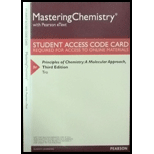
Concept explainers
Two samples of a compound containing elements A and B are decomposed. The first sample produced15 g of A and 35 g of B. The second sample produced25 g of A and what mass of B?
a) 11 g
b) 58 g
c) 21 g
d) 45 g
Interpretation: The mass of element B present in the second sample is to be determined.
Concept Introduction: Joseph Proust in 1797, gave a law of definite proportion. According to this law, all the samples of a compound contains same proportion of their constituent elements regardless of whatever the source of the compound.
Answer to Problem 1SAQ
Correct answer: The mass of B produced by sample 2 is
Explanation of Solution
Justify reasons for the correct statement:
In accordance with the law of definite proportions, the mass of constituent elements in all the samples of a given compound are in the same proportion. This means, in first sample the total mass of a compound i.e.
Thus,
As the ratio of the constituent elements in a compound remains same. Therefore, this ratio is used to calculate the mass of B. Calculate the mass of B as follows:
Rearrange the above expression as follows:
Justify reasons for the correct statement:
Option (a) is incorrect because according to the above calculations, the mass of element B cannot be obtained as
Option (c) is incorrect because according to the above calculations, the mass of element B cannot be obtained as
Option (d) is incorrect because according to the above calculations, the mass of element B cannot be obtained as
The correct answer is option (b).
Want to see more full solutions like this?
Chapter 2 Solutions
Masteringchemistry With Pearson Etext -- Valuepack Access Card -- For Principles Of Chemistry: A Molecular Approach
Additional Science Textbook Solutions
Brock Biology of Microorganisms (15th Edition)
Chemistry: An Introduction to General, Organic, and Biological Chemistry (13th Edition)
Microbiology with Diseases by Body System (5th Edition)
Chemistry (7th Edition)
Microbiology: An Introduction
Campbell Biology: Concepts & Connections (9th Edition)
- A pdf file of your hand drawn, stepwise mechanisms for the reactions. For each reaction in the assignment, you must write each mechanism three times (there are 10 reactions, so 30 mechanisms). (A) do the work on a tablet and save as a pdf., it is expected to write each mechanism out and NOT copy and paste the mechanism after writing it just once. Everything should be drawn out stepwise and every bond that is formed and broken in the process of the reaction, and is expected to see all relevant lone pair electrons and curved arrows. Aldol: NaOH HO H Δ NaOH Δarrow_forwardNonearrow_forwardDraw structures corresponding to the following names and give IUPAC names for the following compounds: (8 Point) a) b) c) CH3 CH2CH3 CH3CHCH2CH2CH CH3 C=C H3C H H2C=C=CHCH3 d) CI e) (3E,5Z)-2,6-Dimethyl-1,3,5,7-octatetraene f) (Z)-4-bromo-3-methyl-3-penten-1-yne g) cis-1-Bromo-2-ethylcyclopentane h) (5R)-4,4,5-trichloro-3,3-dimethyldecanearrow_forward
- Draw a Newman projection from carbon 3 to carbon 2 in the highest energy conformation for the following molecule. What is this conformation called? What kind of strain is present? Brarrow_forwardWhich of the following dienophiles is most reactive in a Diels-Alder reaction: Please explain why the correct answer to this question is option 5. Please provide a detailed explanation.arrow_forwardWhich of the following would you expect to be aromatic? Please provide a detailed explanation.arrow_forward
 Chemistry: Principles and PracticeChemistryISBN:9780534420123Author:Daniel L. Reger, Scott R. Goode, David W. Ball, Edward MercerPublisher:Cengage Learning
Chemistry: Principles and PracticeChemistryISBN:9780534420123Author:Daniel L. Reger, Scott R. Goode, David W. Ball, Edward MercerPublisher:Cengage Learning ChemistryChemistryISBN:9781305957404Author:Steven S. Zumdahl, Susan A. Zumdahl, Donald J. DeCostePublisher:Cengage Learning
ChemistryChemistryISBN:9781305957404Author:Steven S. Zumdahl, Susan A. Zumdahl, Donald J. DeCostePublisher:Cengage Learning
 Chemistry: The Molecular ScienceChemistryISBN:9781285199047Author:John W. Moore, Conrad L. StanitskiPublisher:Cengage Learning
Chemistry: The Molecular ScienceChemistryISBN:9781285199047Author:John W. Moore, Conrad L. StanitskiPublisher:Cengage Learning Chemistry & Chemical ReactivityChemistryISBN:9781133949640Author:John C. Kotz, Paul M. Treichel, John Townsend, David TreichelPublisher:Cengage Learning
Chemistry & Chemical ReactivityChemistryISBN:9781133949640Author:John C. Kotz, Paul M. Treichel, John Townsend, David TreichelPublisher:Cengage Learning Chemistry & Chemical ReactivityChemistryISBN:9781337399074Author:John C. Kotz, Paul M. Treichel, John Townsend, David TreichelPublisher:Cengage Learning
Chemistry & Chemical ReactivityChemistryISBN:9781337399074Author:John C. Kotz, Paul M. Treichel, John Townsend, David TreichelPublisher:Cengage Learning





